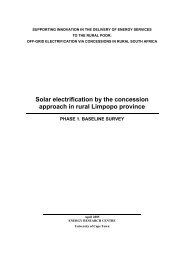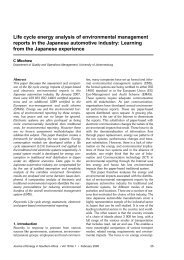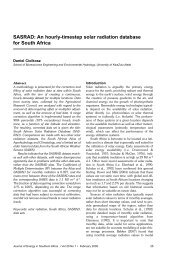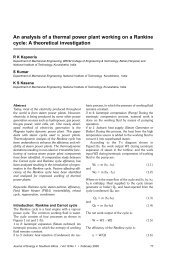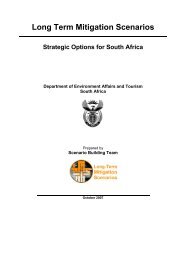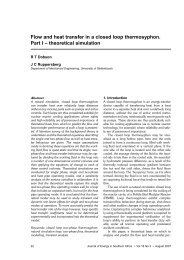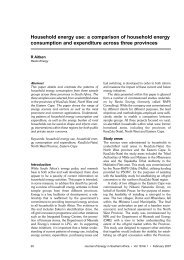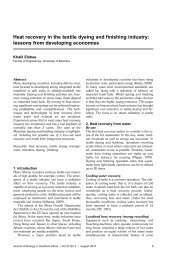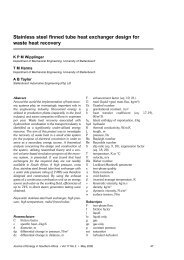Climate variability, climate change and water resource strategies for ...
Climate variability, climate change and water resource strategies for ...
Climate variability, climate change and water resource strategies for ...
You also want an ePaper? Increase the reach of your titles
YUMPU automatically turns print PDFs into web optimized ePapers that Google loves.
<strong>Climate</strong> <strong>variability</strong>, <strong>climate</strong> <strong>change</strong> <strong>and</strong> <strong>water</strong> <strong>resource</strong> <strong>strategies</strong> <strong>for</strong> small municipalities<br />
i<br />
Executive summary<br />
Background <strong>and</strong> motivation<br />
In many parts of the world, <strong>variability</strong> in climatic conditions is already resulting in wide ranging<br />
impacts, especially on <strong>water</strong> <strong>resource</strong>s <strong>and</strong> agriculture. <strong>Climate</strong> <strong>variability</strong> is already being observed<br />
to be increasing, although there remain uncertainties about the link to <strong>climate</strong> <strong>change</strong>. However, the<br />
link to <strong>water</strong> management problems is obvious.<br />
Water is a limiting <strong>resource</strong> <strong>for</strong> development in South Africa <strong>and</strong> a <strong>change</strong> in <strong>water</strong> supply could<br />
have major implications in most sectors of the economy, especially in the agriculture sector. Factors<br />
that contribute to vulnerability in <strong>water</strong> systems in southern Africa include seasonal <strong>and</strong> inter-annual<br />
variations in rainfall, which are amplified by high run-off production <strong>and</strong> evaporation rates.<br />
Current modelling scenarios suggest that there will be significant <strong>climate</strong> <strong>change</strong> 1 impacts in South<br />
Africa (Hewitson et al. 2005). <strong>Climate</strong> <strong>change</strong> is expected to alter the present hydrological <strong>resource</strong>s<br />
in southern Africa <strong>and</strong> add pressure on the adaptability of future <strong>water</strong> <strong>resource</strong>s (Schulze & Perks<br />
2000) . During the past 20 years, most of Africa has experienced extensive droughts, the last three<br />
being 1986-88, 1991-92 <strong>and</strong> 1997-98 (after Chenje & Johnson 1996). If the occurrence of drought<br />
became more frequent, the impact on <strong>water</strong> <strong>resource</strong>s <strong>and</strong> consequently agriculture would be<br />
significant.<br />
Notwithst<strong>and</strong>ing the substantial uncertainties around rainfall projects, there is a tendency <strong>for</strong> the<br />
majority of models to suggest a decrease in rainfall over the western part of southern Africa in the<br />
coming decades. Based on these projections, the most severe impacts are likely to occur in this<br />
region, where small towns <strong>and</strong> subsistence farmers are most vulnerable. The available literature<br />
suggests that it would be prudent to account <strong>for</strong> <strong>climate</strong> <strong>change</strong> in <strong>water</strong> <strong>resource</strong> planning to meet<br />
the development objectives of South Africa. The Minister of Water Affairs, Mr Ronnie Kasrils, has<br />
also acknowledged that “it is possible that the effects of global <strong>climate</strong> <strong>change</strong> will influence the<br />
availability of <strong>water</strong> <strong>and</strong> patterns of use during the next few decades” (Kasrils 2002).<br />
With this in mind, this study investigates the adaptive 2 capacity of small towns <strong>and</strong> communities in<br />
the Northern Cape province to <strong>climate</strong> <strong>variability</strong> 3 , specifically drought. By testing these <strong>strategies</strong><br />
against sustainable development criteria, planning policies <strong>for</strong> national <strong>and</strong> <strong>water</strong> <strong>resource</strong> planning<br />
<strong>and</strong> management are recommended to ensure <strong>water</strong> security against the impacts of <strong>climate</strong> <strong>change</strong>.<br />
Main objectives<br />
1) To demonstrate the <strong>change</strong> in temperature <strong>and</strong> rainfall due to <strong>climate</strong> <strong>variability</strong> <strong>and</strong> projected<br />
<strong>climate</strong> <strong>change</strong> in small towns in the Northern Cape <strong>for</strong> the past 30 years.<br />
2) To document existing coping <strong>strategies</strong> in times of <strong>climate</strong> <strong>variability</strong>, i.e. drought, in small<br />
towns in the Northern Cape.<br />
3) To propose long term <strong>strategies</strong> <strong>for</strong> dealing with the impacts of predicted <strong>climate</strong> <strong>change</strong> in<br />
small towns in the Northern Cape.<br />
1 <strong>Climate</strong> Change: A <strong>change</strong> in <strong>climate</strong> which is attributed directly or indirectly to human activity that alters the<br />
composition of the global atmosphere <strong>and</strong> which is in addition to natural <strong>climate</strong> <strong>variability</strong> over comparable<br />
time periods (Midgley et al. 2005). The time scale would be in decades to centuries.<br />
2 Adaptation: Adjustment in natural or human systems to anew or changing environment. Adaptation to <strong>climate</strong><br />
<strong>change</strong> refers to adjustment in natural or human systems in response climatic stimuli <strong>and</strong> is institutes to<br />
moderate the effects of <strong>climate</strong> <strong>change</strong> (Midgley et al. 2005).<br />
3 <strong>Climate</strong> Variability: Refers to variations in the mean state of the <strong>climate</strong> on all temporal <strong>and</strong> spatial scales beyond<br />
that of individual events. The time scale could be in months to years. (after IPCC 2001b).




